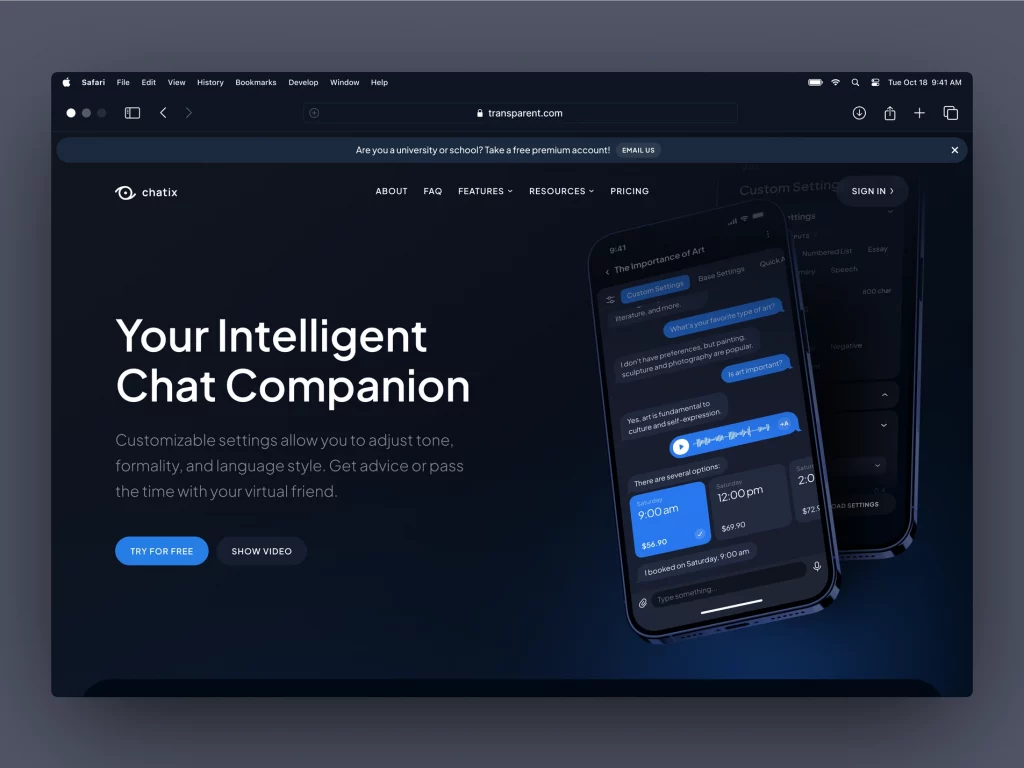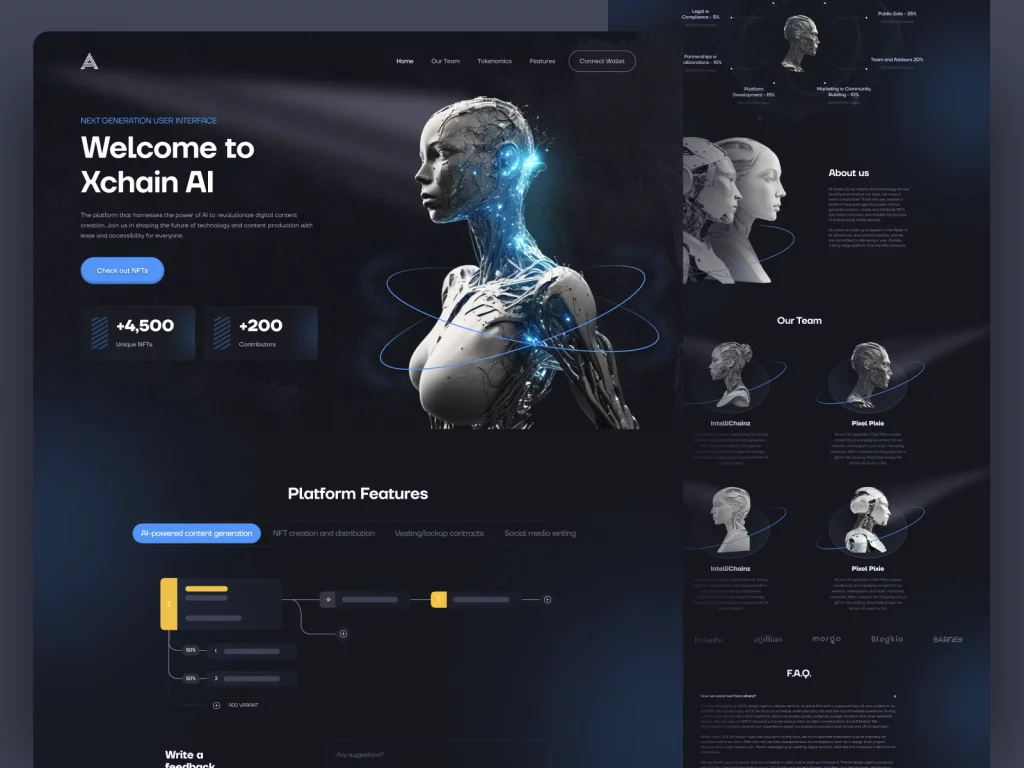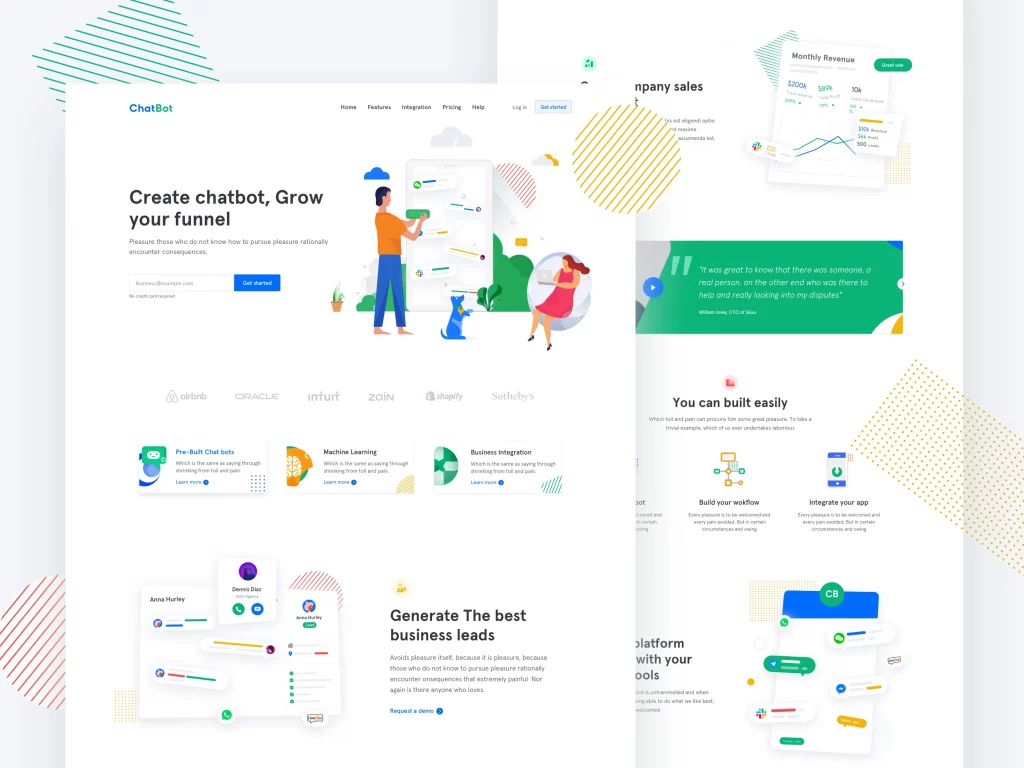Chatbots have become an essential tool for business marketing strategies in today’s digital age. They use artificial intelligence (AI) to streamline and automate customer service operations, saving time and money. However, creating a chatbot that enhances your brand image and delivers a positive user experience can be challenging. In this article, we’ll explore how to design a chatbot using ChatGPT that aligns with your brand image, provides an excellent user experience, and increases customer engagement.
Contents:
According to a report by AllTheResearch, North America has the largest share of chatbot startups, and this market holds 40.4% of the market size. Additionally, the industry’s expected to generate $454.8 million in revenue by 2027, up from $40.9 million in 2018.
In addition to chatbots, voice assistants are also becoming increasingly popular. By 2023, the number of voice chatbots is predicted to rise to over 8 billion. Another trend for 2023 is the rise of AI-powered GTP-3 chatbots, which are powered by a language model developed by OpenAI and present a state-of-the-art natural language processing model.
Introduction to chatbot design
Chatbots are computer programs that mimic human conversations using natural language processing (NLP) and AI algorithms. They can be integrated into websites, social media platforms, and messaging apps, offering 24/7 customer support. Chatbots have become popular as they offer faster response times, instant support, and personalized interactions.
ChatGPT is a state-of-the-art language model that generates human-like responses using deep learning algorithms. It can understand complex queries and deliver accurate responses, making it an excellent tool for chatbot design. Businesses can use ChatGPT to create customized chatbots that align with their brand image.
Understanding artificial intelligence and natural language processing
AI and NLP are crucial to bot technologies. AI enables chatbots to understand and process human language, while NLP allows them to recognize speech patterns and respond accordingly. Rule-based and machine learning-based AI are the two types used in chatbots. Rule-based chatbots follow predefined rules, while machine learning-based chatbots improve their responses over time by learning from data.
NLP allows bots to analyze and understand natural language inputs. Rule-based, statistical, and hybrid NLP are the three types used in chatbots. Rule-based NLP uses pre-programmed rules to understand user queries, while statistical NLP uses machine learning algorithms to analyze language patterns. Hybrid NLP combines both approaches to achieve higher accuracy in understanding user queries.
Benefits of AI and NLP in chatbot design
The use of AI and NLP in chatbot design provides several benefits, including:
- Improved customer experience: Chatbots that use AI and NLP can provide personalized responses that enhance customer satisfaction.
- Increased efficiency: Chatbots can handle multiple customer queries simultaneously, thereby reducing response time and improving efficiency.
- Reduced costs: Chatbots can handle routine customer queries, thereby reducing the need for human customer service representatives and saving costs.
Importance of branding and conversational UI
In design, branding involves designing a bot that aligns with the brand image of a business. One that reflects the personality of a business can enhance brand recognition and customer loyalty. Additionally, designing a conversational user interface (UI) is essential in chatbot design. A conversational UI refers to a design that mimics human conversation, providing a seamless and natural customer experience.
Tips for designing a conversational UI that aligns with your brand image
- Understand your brand personality and tone of voice.
- Use language that reflects your brand identity.
- Create a chatbot persona that aligns with your brand image.
- Use visual elements that align with your brand.
Focusing on user experience and personalization
UX is critical in chatbot design. A well-designed one should provide a seamless user experience that is easy to navigate and understand. The responses should be concise, relevant, and easy to comprehend. Businesses should also ensure that their chatbots are accessible to users with disabilities.
Tips for designing a chatbot with an excellent user experience
- Provide clear instructions: Ensure that it provides clear instructions on how to interact with it. Use simple and concise language to explain how the chatbot works and what it can do.
- Use natural language: Design one that can understand and respond to natural language queries. Avoid using technical jargon or complicated language that may confuse customers.
- Ensure responsiveness: Ensure quick reactions to customer queries. Slow response time can frustrate customers and reduce their satisfaction.
- Use buttons and quick replies: Use buttons and quick replies to provide customers with predefined responses. This makes it easier for customers to interact with the chatbot and can improve their experience.
Personalization is another critical aspect of chatbot design. Personalized chatbots can deliver more relevant and personalized responses to users, making them feel more valued and engaged. Businesses can personalize their chatbots by using the user’s name, past interactions, and preferences. Personalization can increase customer satisfaction and loyalty, leading to higher sales and revenue.
Leveraging machine learning and human-in-the-loop
The development of chatbots has been revolutionized by advancements in machine learning, which has enabled chatbots to provide more personalized and human-like interactions. Machine learning algorithms are responsible for training chatbots to understand customer intent and respond with the appropriate actions.
However, the role of human-in-the-loop cannot be overemphasized in bot design. Human-in-the-loop refers to the involvement of human operators in the chatbot’s decision-making process, which is critical for ensuring that chatbots provide accurate responses and meet customers’ needs.
Benefits of using machine learning and human-in-the-loop in chatbot design
By leveraging both machine learning and human-in-the-loop, businesses can benefit from the following:
- Improved accuracy: Human-in-the-loop ensures that chatbots provide accurate responses, eliminating errors that could potentially harm the business’s reputation.
- Enhanced personalization: Machine learning algorithms analyze vast amounts of data to understand customer preferences and personalize interactions. By incorporating human operators, chatbots can provide even more personalized experiences.
- Increased efficiency: Chatbots that use machine learning can handle a high volume of requests simultaneously, freeing up human operators to focus on more complex tasks.
Boosting customer engagement and lead generation
Chatbots are becoming increasingly popular in customer engagement and lead generation. By offering a 24/7 virtual assistant, chatbots can help businesses engage with customers in real time, offering support and guidance as needed.
Tips for designing a chatbot that boosts customer engagement
- Offer personalized experiences: Use machine learning algorithms to understand customer preferences and personalize interactions.
- Respond quickly: Customers expect instant responses, so ensure that the bot is programmed to respond quickly to customer queries.
- Offer clear and concise responses: Ensure that the chatbot’s responses are clear and concise, so customers can easily understand and act on the information provided.
Understanding the role of chatbots in lead generation
Chatbots can also play a crucial role in lead generation by qualifying leads and guiding them through the sales funnel.
Tips for designing a chatbot that generates leads
- Qualify leads: Use chatbots to ask qualifying questions to potential leads and identify those who are ready to move forward in the sales funnel.
- Provide relevant information: Offer potential leads the information they need to make informed decisions and move forward in the sales funnel.
- 24/7 outreach: They can reach prospects outside of usual work hours, which is a significant bonus.

ChatGPT prompt assistant website by Conceptzilla
Incorporating voice assistants and multilingual chatbots
Voice assistants, such as Amazon’s Alexa and Apple’s Siri, are becoming increasingly popular in design. Voice assistants enable users to interact with chatbots using voice commands, making the interaction more natural and intuitive.
Understanding the role of voice assistants in chatbot design
By incorporating voice assistants, businesses can benefit from the following:
- Improved user experience: Voice assistants provide a more natural and intuitive interaction, which can improve the overall user experience.
- Increased accessibility: Voice assistants make it easier for users with disabilities to interact with chatbots.
- Removed language barriers: Voice assistant technology connects with translation services, assisting your company in dealing with any language obstacles that may arise.
Tips for designing a chatbot with voice assistants:
- Use natural language processing: Incorporate natural language processing (NLP) to enable the chatbot to understand and respond to voice commands.
- Optimize for voice search: Ensure that the chatbot’s content is optimized for voice search, so users can easily find the information they need.
- Give control to the users: While onboarding or subscribing your users to notifications, remind them that they are in control and may simply change their minds in the future.
Understanding the importance of multilingual chatbots
With businesses operating globally, multilingual chatbots have become essential in providing customer support in different languages.
Tips for designing a chatbot that supports multiple languages:
- Use machine learning algorithms: Use machine learning algorithms to analyze customer preferences and provide personalized responses in different languages.
- Hire native speakers: Hire native speakers to ensure that the chatbot’s responses are accurate and culturally appropriate.
- Test on native speakers: Do regular A/B testing to see if everything works fine and how to improve interactions.
Additionally, it’s important to consider the technical aspects of designing a multilingual chatbot. The bot should be designed to recognize and process multiple languages and dialects accurately. It’s also important to provide users with the option to switch between languages easily.
Designing a multilingual chatbot requires a significant investment of time and resources. However, it can significantly expand your brand’s reach and improve the customer experience for users who prefer to communicate in their native language.
Analyzing chatbot performance and optimizing it
Designing a chatbot is only half the battle. Once it is live, it’s important to track its performance and optimize it to improve its effectiveness continually. Here are some tips for analyzing chatbot performance and optimizing it:
- Use chatbot analytics tools: Use analytics tools to track the chatbot’s performance, including user engagement, conversion rates, and response times. Analyzing this data can help you identify areas for improvement and optimize the chatbot’s performance.
- Identify key performance indicators (KPIs): Identify the KPIs that matter most to your business, such as customer satisfaction ratings or conversion rates. Use these metrics to track the chatbot’s performance over time.
- Optimize the chatbot’s responses: Utilize the data collected from analytics tools to optimize the chatbot’s responses continually. This can include refining the chatbot’s natural language processing (NLP) algorithms or updating the chatbot’s responses to common questions.
- Implement A/B testing: Use A/B testing to test different variations of the chatbot’s responses and user flows. This can help you identify which chatbot design elements and responses are most effective at engaging users and generating leads.
Ensuring chatbot security and testing
Chatbots collect sensitive information from users, such as personal information and payment details. Therefore, ensuring the security of chatbots is critical to protecting users’ data and maintaining their trust. Here are some tips for designing a secure chatbot:
- Use HTTPS: Use HTTPS to encrypt data in transit between the chatbot and the user’s device. This helps prevent man-in-the-middle attacks and data interception.
- Implement authentication and authorization: Implement authentication and authorization protocols to ensure that only authorized users can access the chatbot and its data.
- Encrypt sensitive data: Encrypt sensitive data such as passwords and payment details to prevent unauthorized access.
- Regularly test the chatbot’s security: Regularly test the chatbot’s security by conducting penetration testing and vulnerability scanning. This can help identify potential security vulnerabilities and enable you to take appropriate action to address them.
Designing industry-specific chatbots
Chatbots can be designed for use in almost any industry, from healthcare to retail to finance. Here are some tips for designing chatbots for different industries:
- Healthcare: Make sure it can assist patients with booking appointments, accessing medical information, and receiving medical advice.
- Retail: Help customers with finding products, processing orders, and tracking deliveries.
- Finance: Design chatbots that can assist customers with account management, loan applications, and financial advice.
- Travel: Design chatbots that can assist customers with booking flights, hotels, and rental cars, as well as provide travel recommendations.
Case studies on industry-specific chatbots can provide inspiration and best practices for designing chatbots that meet the unique needs of each industry.
Conclusion
In conclusion, designing a chatbot with ChatGPT that enhances your brand is crucial in today’s digital age. Businesses can use AI and NLP to streamline and automate customer service operations, offering faster response times, instant support, and personalized interactions. By aligning the chatbot’s personality with the brand image, designing a user-friendly interface, and focusing on user experience and personalization, businesses can build stronger relationships with customers, increase customer loyalty, and drive higher sales and revenue.
Looking to enhance your brand by developing or designing your website? Contact us and our team of experts will build you a competitive and stunning product.


